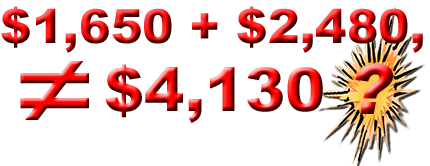Separate But Not Equal?
 When does the creative/usage fees a photographer recieves of $4,130 not equal a creative fee of $1,650 + and a licensing fee of $2,480?
When does the creative/usage fees a photographer recieves of $4,130 not equal a creative fee of $1,650 + and a licensing fee of $2,480?
You might say, "John, I remember second grade math, and they're the same."
There is a debate that rages over this subject. There are valuable points to be made about the risks that accompany separating out the creative fee from your licensing fee, and there are many cases where doing so is a bad idea.
That said, there are many cases where having them combined is the right solution.
What's that you say? Can't you just make one size fit all?
(Continued after the Jump)
Nope. Doesn't work that way.
Even when I say "banish the day rate", I say that in reference to editorial and corporate/commercial work. It just is a bad bad approach. However, if you're a photographer shooting on-camera flash at an all day symposium, billing out at $150 an hour, where that rate is with a minimum of X hours, is appropriate, and also includes not just your actual on-site time, as well as your creativity, but also the client's usage fee for those images. Some people might get $200/hr, some $250/hr, and I know more than enough that only charge $75/hr. All of these are plus expenses/post production, and so forth.
When you're doing a highly stylized production shoot, where, while it was just one day of principle photography, it was a lot of other time spent tech scouting, pre-production scouting, conference calls, and client meetings, wrapping all the fees together is appropriate.
When you're doing a product shot on white seamless, where you're applying your creative vision to making it more than "just a product on white seamless", this is one case where separating them out makes more sense. You list your creative fee at, say, $1,800 for the shoot, where the final deliverable is one licensed image, and then $12,000 for a licensing package that extends over two years. Why? Because if the fee is wrapped up all together, the end client will look at your paperwork and say "I'm not paying $13,800 for a photographer to take one photo for me...", and you may well lose the assignment. However,
when you break it apart, and it says "$1,800 creative fee" and "$12,000 licensing package, as outlined below for two years", the end client can look at that and see the breakdown. This can help them understand what they're paying for, and that you're not a $13,800 "a day" photographer, for one days' work, but rather, you're an $1,800 "a day" for the photographer and a $12,000 "for two years" licensor.
I encounter clients all the time that need explanations about the difference. Further, I know of many photographers - top tier as well as mid-level, who go through this. Often, it's the end client who needs the explanation more than the middle-person (whether firm, or agency), and their having to explain it to their client is not as good as it's being done already.
Wish it were not the case, but photographers/reps/etc find ourselves an inordinate amount of the time having to explain rights to clients, more than we'd like. We appreciate when clients don't need that explanation, that someone else has done the hard work already.
When you're dealing with an agency that licenses music, footage, high profile talent, and so forth, you almost never have to explain it. In fact, if you're not careful, and you do begin to explain it, the prospective client will be thinking "what am I, stupid?" and you're off on the wrong foot.
When you have an ongoing relationship with a client, and you know how they prefer to receive estimates, you follow their protocol (in other words, meet their needs as well as meeting your own), but that is based upon an ongoing relationship. In fact, in once instance for example, where I was estimating a job for a major agency, that was in excess of $10k, I had put the creative and licensing fees together, as one, and the art buyer called and asked for a break-out of the two. I was happy to provide that to her, and it resulted not only in my being awarded the job, but I've done 11 other comparable jobs for them over the last 2 1/2 years for the campaign to date, and I am scheduled to do four more before June. So far, 12 assignments for a major agency have netted me in excess of $120k, because I did it the way the AB asked me to, and it is a wonderful, ongoing relationship.
EVERY SINGLE TIME I have an opportunity to explain to a prospective client how things work vis-a-vis licensing and fees, I welcome it, because as I explain it, I become a resource/knowledge-base for them, and they often then become an ongoing client. In fact, my studio manager and post production manager listen intently as I explain these things to folks who call, and when I get off the phone, I usually can tell if I'm getting the assignment, or not. They like to hear that I still have to do it, and they sometimes will listen on another extension in the office because I want them to become as adept as explaining it as they can, so they can help me in a pinch, and will be better positioned to do it themselves when they leave to go out on their own.
Further, and most importantly, you must be prepared to work through the numbers above the Total line so that they work for the client and the client's client. If you're not, you're risking losing the entire job because you won't shuffle the numbers around. I've had clients who have said "you can't line-item an assistant's airfare, but you can roll that into excess baggage charges...", or "I need you to break out hair, makeup and stylist. I know they're all the same person for this shoot, but I can explain it easier to the client if they don't see a $2,600 hair/makeup/stylist charge for a one day shoot for one person.
If you break it up, as hair - $350, Makeup - $350, Stylist Shop/Present/On Set/Returns - $1,900, I can better explain that to the client". Lastly, When a prospective client says they want a $15,000 figure broken into creative fees and licensing fees, I'm going to do that. It may call for some further explanation, and I may break it into other fees that previously weren't separately listed - like Pre-Production/Location Scout/Tech Scout/Permitting Services/Set Build/Set Strike, but I'm not going to lose a job with a bottom line I am comfortable with because I wouldn't re-work the above-the-line numbers.
A mechanic's tool chest has many drawers. a 13mm socket also works (sort of) on a 1/2" nut. A crescent wrench isn't as good a plumbers' monkey wrench, which then again may be better accomplished using a fixed-size wrench. Knowing which tool is the right one for the job is why there's a difference between a journeyman mechanic and a master mechanic. In the end, the repair work done, but it's having the right tools at your disposal to get from start to finish in the best way possible.
Knowing which methodology you prefer, and how you can work to accommodate client requests is a matter of experience. Knowing that you should do what you can to accommodate client requests is a no brainer. Asking the client questions - like "is this a bid or an estimate", and "is this assignment going to be awarded on price, or are there other factors like style and approach that are more important" will be helpful.
In the end, send along the estimate, and follow up to confirm they've received it. Ensure them that if they have any questions, or require further explanation about an item, that you are more than happy to explain it to them. When you're dealing with someone experienced, and who can explain it to their clients, you won't get any calls. When you're dealing with someone who's never hired a photographer before, you'll get calls. Take that as an opportunity to help this client so that they feel you are helpful and willing to be of assistance. I know of far to many cubicle-jockeys with creative talent that did not understand the need to be responsive to client needs and deliver first rate customer service.
If as a photographer you remain rock-solid in your insistence on keeping the figures together when the bottom line figures do not change, and you will just never separate them, that's somewhat problematic, from my perspective, especially if, as a result, clients just opt not to call you/your photographers. Just as we negotiate things like terms (net 30, 50/50, 2/10 net 30, and so forth) as well as credit line placement (or lack thereof), exclusivity, and the many other myriad of issues that are a part of a negotiation, so too do we negotiate other issues as well, and that can include things like separate/together for the fees.
A step in the wrong direction would be to lose the job because you didn't know what to do, or were inflexible/unresponsive. There are many steps in the right direction, there isn't just one right direction.
Note: This post is a compilation and slight edit (for continuity) of two messages I made on an ASMP listserv. Since the content above is mine alone (i.e. it's what I wrote, and not someone elses' writings), I am presenting it here as well.
Please post your comments by clicking the link below. If you've got questions, please pose them in our Photo Business Forum Flickr Group Discussion Threads.

2 comments:
"A mechanic's tool chest has many drawers. a 10mm socket also works (sort of) on a 1/2" nut."
Not quite, it's a 13mm that's semi-comparable to a 1/2". Along with 7mm to 9/32 - 8mm to 5/16 -19mm to 3/4. 15mm is also a real sloppy fit for 9/16 just as 5/8 is really sloppy on a 16mm.
Phew, now I'll be able to sleep at night knowing tha's straightened out.
Also wanted to let you know I really enjoy the blog. I started reading it after picking up a copy of Best Business Practices..., which I also enjoyed very much.
I'm not in business for myself yet and may never be but it's one of the options that I'm considering. Both the book and blog have been excellent resources and will keep me from just jumping into something that's way over my head.
Alan --
You're right, and I've updated the blog entry to reflect the correct "mm". Thanks! :-)
John.
Post a Comment